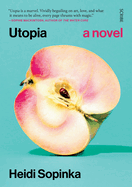
Heidi Sopinka's Utopia opens at a party with the first-person perspective of Romy, a performance artist, directly addressing her months-old daughter. The evening ends with an unexplained tragedy, and from there the novel jumps forward some months to follow a young woman named Paz, who is now raising Romy's baby and is married to Romy's husband, Billy. It is 1978, and Paz, Billy and all their friends are steeped in the Los Angeles art scene, where sex, drugs and free expression are soured by competition, infighting and wildly different rules for male and female artists. Paz attends women's groups and wishes for a freer life for herself, but many women see her as having taken over Romy's life in decidedly unfeminist fashion. Romy, the more successful and established artist, casts a long shadow. Caring for Romy's baby, lost in reading Romy's journals, Paz finds herself in something of a love triangle with a ghost, and begins to lose grasp of her own life and art. And then a postcard arrives, apparently from Romy. It is labeled "disappearance piece."
Utopia cleverly investigates layers of social issues: feminism and its intersections with race and class; gender roles in life and in art; women's relationships; the artist's relationship to commerce and social justice. The central narrative belongs to Paz, but that narrative is always shadowed by Romy. Sopinka (The Dictionary of Animal Languages) excels in characterization and the evocation of the power of creation. In pursuing her predecessor's mysterious end, Paz must put herself in real danger and explore the very edges of not only art but existence. --Julia Kastner, librarian and blogger at pagesofjulia

